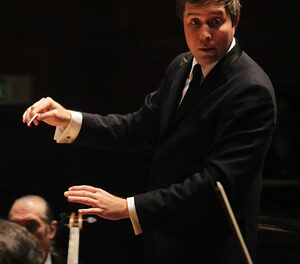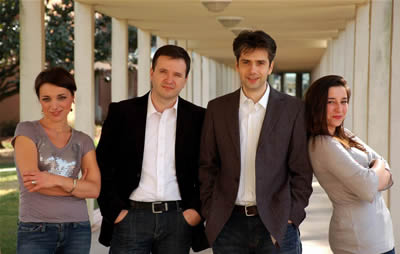The long, printed program title, “Baroque, Tango, and Ragtime: The Global Eclecticism of Fritz Kreisler,” precisely described the nature of the first classical concert in this season’s Carolina Summer Music Festival. Wake Forest University based-violinist Jacqui Carrasco chose an imaginative program more characteristic of recitals in the early 20th century, before World War II. Carrasco commented upon the selections from the stage of the well-filled intimate hall in the Reynolda House Museum of American Art. Most of the selections were expertly supported by University of North Carolina Greensboro-based pianist James Douglass. The piano lid was fully raised and the balance between the violin and the piano in the duo selections was perfect.
Fritz Kreisler (1875-1962) was born in Vienna and was one of the finest and most beloved violin virtuosos in history. He recorded from the earliest days of sound recordings through 1950. Carrasco’s selections ranged from short pieces Kreisler composed under his own name through works he originally claimed to have been “newly discovered lost works” from famous Renaissance and Baroque composers. This myth held for some thirty years until Kreisler admitted he had composed these conservative compositions to fill out his programs and to avoid having his name so often listed as composer on his programs. Recitals of this period were less a serious selection of sonatas but more of a lighter nature with greater emphasis on showpieces.
Carrasco and Douglass opened the program with Kreisler’s “La Gitana,” which has a Hungarian flavor, giving the violinist ample chance to apply Kreisler’s characteristic style. This included a sweet tone, continuous vibrato, expressive phrasing, emphasis on melody and, not least, considerable use of portamento and rubato. Carrasco said she was using slides to try to give an impression of Kreisler’s playing. The varied violin melody floated above Douglass’ solid keyboard rhythm.
The next set of three duo selections featured Kreisler as the “finder of long lost scores.” The first two, “Andantino” and “Preghiera,” are warmly melodic bonbons in the style of Giovanni Battista Martini. This was richly romantic in style. The “Tempo di Minuetto” in the style of Gaetano Pugnani (1731-98) has more early classical music flavor with a romantic overlay.
Kreisler’s Recitativo and Scherzo, Op. 6, for solo violin, features adventuresome use of harmonics and plenty of technical challenges which Carrasco met with aplomb. Douglass rejoined her for the charming duo “Berceuse Romantique,” Op. 9.
A contemporary musical approach was on tap in Kreisleriana for Violin and Piano (1912) by Harold Meltzer (b.1966). This was a commission from the Library of Congress commemorating the 50th anniversary of Kreisler’s death. Carrasco speculated there might be a double meaning in the title. Meltzer’s work has short pieces in various styles, such as ragtime, the blues, and even a Copland-like section, making the collection a modern version of Kreisler’s bonbons. The title could also suggest Robert Schumann’s famous set of character pieces for piano. Carassco and Douglass gave this smorgasbord a brilliant and delightful performance.
The final set of four works was a richly satisfying survey of some of Kreisler’s best loved works: “Marche Miniature Viennoise,” “Caprice Viennois,” Op. 2, Tango (Albéniz-Kreisler), and “Syncopation.” Carrasco and Douglass brought out all the charm and lightly worn virtuosity in these works.












